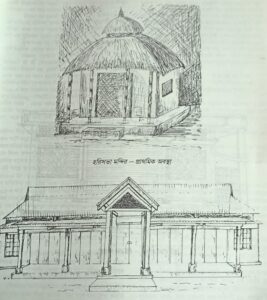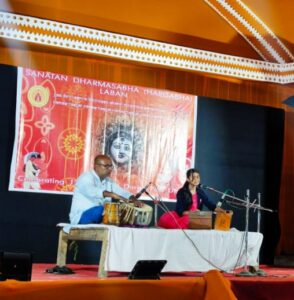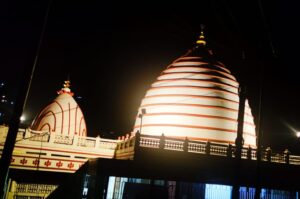Years under the divine light
At least 8 Durga Puja committees in the city will celebrate their journey of 50 years and above

The agamoni geet (welcome song) on Mahalaya morning marked the advent of Durga Puja, the biggest festival of the Bengalis and other Hindu communities, in particular and the subsequent festivities in general. The hills of Shillong are already reverberating with chants of mantra and intermittent rhythms of dhak (drum) as several Bengali, Assamese, Bihari, Marwari and other communities in several localities. The tempo of celebrations is high this year as the Covid-19 pandemic marred the festive fervour in the last two years. Many puja committees in the city are preparing for celebrations of their long journey. At least three puja committees will celebrate the festival’s centenary year, the oldest among them being Laban Harisabha that is in its 127th year.
Sunday Monitor speaks to the organisers of those pujas which are celebrating golden jubilee and above to find out what grandeur is in store for the four days of Durga Puja beginning next weekend. In the process, it also finds out the reminiscences of the olden days and the tribulations in carrying forward the glorious legacy.

Sanatan Dharmasabha, Laban: The puja, which is popularly known as Harisabha puja, will complete 127 years. However, the puja committee could not celebrate its quasquicentennial year in 2020 owing to the pandemic and had postponed it to 2022. This is the oldest puja in the hill city that traces its history to 1896. In fact, the Harisabha Durga puja was the first in the hills. When Shillong became the capital of Assam Province in 1874, several Bengali employees of the government settled here and felt the need to set up a cultural and religious congregation. The Harisabha is the result of the hard work of a few prominent members of the community. In the beginning, Harisabha was only a bamboo and thatch structure and the puja was devoid of the glitz that marks the festival today. Every year before the puja, the thatch was rebuilt. The permanent structure came up in 1927 at the cost of Rs 1,200. At present, the puja is organised inside the permanent structure.
Over the years, the Harisabha Durga Puja has evolved to become one of the important destinations for revellers and devotees alike. Though the razzmatazz of the modern times has become a part of the puja, the committee has not forgotten the traditions. Cultural events are still an integral part of the festivity and the 125th year celebrations were kicked off with music, dance and art.
Debashish Chakraborty, who grew up in the locality and has been associated closely with Harisabha for decades

now, informed that one of the households in the locality has been donating Benarasi sari to the goddess for almost 50 years now. He also talked about the transition in the managing committees. “Earlier, only the elderly would be at the helm of all affairs of the Harisabha and the puja. Now, young people are taking the legacy forward,” he said.
The participation of people from all age groups, including teenagers as volunteers, in the festivity and its preparations is what makes the Harisabha puja complete.
The history of the Harisabha Durga puja is not just about a community or a locality but that of Shillong too. Hence, the celebration of the years traversed is imperative.
Asomiya Namghar, Lower Jail Road: The puja, which was started by late Gopal Chandra Das in 1923, has witnessed a century. Initially, the puja would be organised by members of the Assamese community. But as the city turned more cosmopolitan, other communities too started participating in both management and celebrations of the puja.
Binod Kunar, secretary of the puja committee, said besides Bengalis and Assamese, Biharis and Nepalese are also active during the festival. Kunar, who is in his early fifties, grew up in the locality and has colourful memories of the puja.
Cultural events were always on focus during the festival and youths were active participants. The khichdi at the mandap was also popular. Some of the traditions are still being followed.
To kick-off the year-long centenary celebrations, the puja committee has planned a multilingual souvenir that will be launched by Deputy Chief Minister Prestone Tynsong on October 2. There are several cultural programmes and competitions, like rangoli and painting, on the four days of the festival to engage the youths and the children in the locality.
Over decades, the demography of the locality has changed and so has the puja that has become elaborate with the participation of more people. However, Kunar rued the apathy of the youth to take part in the festivities and blamed technology for the distractions. “They don’t believe in religious rituals and often want to stay away from these. This is sad as we should not forget our tradition. We, the adults, in the puja committee are trying our best to involve them through interesting events and competitions,” he added.

Laban Namghar: With the formation of the Laban Assam Club in 1896, the Assamese community also set up a society that would organise festivals and cultural events. The puja was first organised in 1922 at the residence of Kamala Kanta Barooah in Laban. It was later shifted to the premises of the namghar.
Old-timers say the idol would come from Guwahati and the vehicles plying on Guwahati-Shillong road would transport those free of cost.
The century-old puja tells the story of a community and its cultural and spiritual evolution in Shillong.
(Also read: 100 years of faith & integrity)
Anup Chand Lane, Police Bazar: Three quarters of a century is a long journey and this puja has completed it despite the travails of time. True that celebration of 75 years is a part of the Durga Puja here this year, but the uncertainty of the journey ahead clouds the minds of the organisers.
Mrinal Kanti Dey, president of the Durga Puja Committee at AC Lane, told Sunday Monitor that lack of a permanent space for the puja and cash crunch are the organisers’ primary concern.
The puja, which started in 1947, would be organised on the premises of Prabhu Dayal Jhunjhunwala’s property in

AC Lane till 2002. Then, it had to be shifted to a land nearby because construction started on the earlier site. “The plot belonged to Pamu Das (father of filmmaker Pradip Kurbah). He told us that the puja committee could use the plot for the festival till the time no construction happened. Of course, there was a plan to start construction last year but it did not happen. We have been assured that even if a building comes up, we can use the parking space for holding the puja,” he said. The puja
Dey said the founder members of the puja committee were Chandrasekhar Sinha, Kalachand Sharma, Nasib Chand Chauhan, Raman Dhar, Kshitish Dhar, Dipchand Malkani and Khirodnath Roy. They were in-charge till 1978. However, there was neither an organised committee nor records of accounts. In 1979, Pranesh Dey, the present secretary, took charge along with few others and strengthened the puja committee.
Over the years, the puja has had been witness to several socio-political upheavals in the city and the Bengali community in the locality had to struggle to celebrate the annual festival. Dey recollected the tumultuous times of 1980 and 1981 when the district administration denied permission to several puja committees. “In 1980, our idol was also ready but finally we had to cancel it. For two consecutive years, we had to go for ghat puja (symbolic rituals),” he added.
Again, in 1987 and 1992, the puja committee held ghat puja owing to communal violence and subsequent curfews. Collecting donations for the festival was also difficult during that period. In 1998, the puja completed 50 years and it was celebrated in a big way.
The puja committee did not collect donations in the pandemic years and organised ghat puja. “We had put up a flex banner with the photo of the goddess in the background. We got sponsors for the flex banners,” Dey said.
On its 75th year, the puja committee is not planning any grand celebrations due to lack of space and fund. Dey said a lion’s share of the donation is spent on cleaning the site and putting up the pandal. “Now, collection of donations is also drying up. It is becoming an arduous task to continue the puja. Let’s see what happens,” he informed.

Kench’s Trace: The puja Kench’s Trace near Bishnupur will also celebrate 75 years and its cultural events will be the highlight. Monica Chanda of Gitanjali Dance Academy is planning to create rangoli designs on a 15-m stretch of the road leading to the pandal. “We will use paint so that the designs remain for long. But it depends on the weather condition,” said the danseuse, who is the vice-president of the puja committee and co-chairperson of the celebration committee.
The dance academy is also planning a folk dance, Ojha, which is a tradition of East Bengal. “It has its origin in Padmapuran that is read in the Bengali month of Shravan. Many people are not aware of this dance form. So, I am planning to perform this,” she said.
The cultural celebrations will also have a flavour of the 75 years of India’s independence.
Shree Shree Rajasthan, Lukier Road: The puja near Garikhana will complete 63 years. But the puja committee missed the diamond jubilee celebrations owing to the pandemic and is planning a grand festival this time.
Ajay Agarwal, the president of the committee, said the puja was started by the Marwari community in 1960 with a paltry donation of Rs 70-80. Instead of an elaborate idol, the members performed the rituals in front of a framed photograph of the goddess. With time, the celebration grew in volume and grandeur as more community members participated. The number of puja committee members has also increased from 7-8 to 67.
Agarwal said the focus this year is on the pandal and light decorations. “The pandal is being put up over 17,000 sqft and we are particularly focusing on the illumination. Ours will be the best puja in terms of pandal and decorations this year,” added the 52-year-old president. The committee has hired decorators from Guwahati. The idol will also come the neighbouring state.
The puja canteen, which is set up outside the pandal each year, is popular among revellers and this time too, the organisers are hoping to have a huge footfall.
Agarwal said after a hiatus of two years, people will throng pandals this time in large numbers. So, the organisers and volunteers at the pandal are already prepared for a large crowd on the four days of the festival.
Oakland-Bivar Road, Oakland: It will be a golden moment for the puja here this year. The puja was started by a group of businessmen 50 years back with donations from committee members. Septuagenarian JK Das, who is closely associated with the organising committee, said the first puja was held in the field opposite Assam LP School in the locality. He was then a young man of 25 and, along with other youths in the neighbourhood, would take part if the preparations and cultural events. The venue was shifted to the community hall in 1976.
Earlier, the organising committee had the predominance of Assamese but as their population decreased in the hill city, the vacuum was filled up by Bengalis.
Reminiscing about the puja decades back, Das said there were less administrative restrictions and people would enjoy to their heart’s fullest. “Also, everyone would cooperate during puja. But that is not the case now. There were no restrictions during immersion and we would carry the idols, which were humble in size, on our shoulders to the stream. The cultural events were also many. The puja was humble but the joy was immense,” he recollected.
Ajay Paul, president of the puja committee, said the organisers have especially brought decorators from Alipur Duar in West Bengal. The budget for this year has shot up to over Rs 30 lakh from Rs 5 lakh in the previous year. A team of dhakis (drummers) will come from Kolkata and four of its seven members are women, informed Paul.
The celebrations kicked off with sports like cricket, carrom and table tennis and a food festival. An array of events like various competitions is also lined up for the four days of the puja. There will be a cultural programme and drama evening on Ashtami and Navami, respectively.
Laban Shiv Mandir: The puja at Laban Shiv Mandir will also celebrate 50 years. The puja, which is performed inside the temple, was started by youths mainly from the Bihari community. Joybrata Roy, president of the puja committee, said the festival is endeavour of a mixed community that adds hues of colours to the celebrations.
The 58-year-old organising head said nothing much has changed over the years. Unlike other years, this time, a small pandal is being set up on the humble courtyard of the temple while the main rituals will be hold inside the temple.
Roy informed that the puja committee also organises Kali puja that is older than the Durga Puja. “It completed 50 years in 2018,” he added.
~ Team Sunday Monitor
~ Photos by MM, sources




